
Still roaming wild but for how long ?
I believe cats to be spirits come to earth.
A cat, I am sure, could walk on a cloud without coming through.
(Jules Verne)
Dear readers,
Nature in Scotland with its unique landscapes, rich fauna and flora, is one of our favourite subjects and today I’d like to draw your attention to the Scottish wild cat, a magnificent creature called the ‘Tiger of Scotland’ still roaming wild in the forest of the land. But for how long will it be roaming there, nobody knows for it is an extremely endangered species.
(The Scottish wildcat Source BBC News Highlands & Islands 2013)
BBC News
Highlands & Islands
21 May 2013
Scottish wildcat could be extinct ‘within two years ‘A scientist who has developed a genetic test to identify pure Scottish wildcats has warned that the species could be extinct within two years.
Dr Paul O’Donoghue said cross breeding with feral and hybrid cats made extinction a certainty unless “urgent” conservation activity took place.The University of Chester biologist said pure wildcats should be trapped.
http://www.bbc.co.uk/news/uk-scotland-highlands-islands-22610869
We didn’t see any wild cat during our seven trips to Scotland but we would have been extremely lucky to see one peeking out from some solitary and remote shelter only known to him and still more lucky to be able to take a picture of it for the wild cat is not only rare and as its name indicates it is very wild.
The wild cat of Scotland Source Highland Tiger
http://www.highlandtiger.com/index.asp
As it is better to see a wild cat (or other wild animals) within the limits of a park or a zoo than none at all we’ve planned to visit the Highland Wild Life Park and Edinburgh zoo in our next trip to Scotland.
We currently have three Scottish wildcats in our collection, two males and one female. In February 2013 three males and one female moved down to Edinburgh Zoo.
In August 2013 we welcomed the birth of two wildcat kittens into our collection. They have been named Ness and Einich.
Our cats in the Park can often be found on a tree branch, in the aerial walkway or in one of the stone cairns in our Forest Habitat. They are fed mainly on rabbit. The rabbits’ furry skin is left on to provide roughage and interest, with extra ‘carnivore’ vitamins added for health. As meat eaters, wildcats spend long hours sleeping and digesting their food during the day.
http://www.highlandwildlifepark.org.uk/animals/detail/scottish-wildcats/2656
Mike Tomkies, a great naturalist and writer, is among the best defenders of the wild cat cause.

As a fan of Mike Tomkies and of Moobli, his faithful and beloved german shepherd, I’m very happy to find here a good opportunity to pay homage to master and dog ;-). Mike Tomkies who lived with his dog in Wildernesse, a wooden house he had built on Eilean Shona, a remote island off the west coast of Scotland, had adopted two little wildcat kittens and taught Moobli not only to live on friendly terms with them, which finally proved quite easy (‘Proof of a Tender Heart’), but also to track wild cats (among other animals) in the wilderness.
Below is an extract from ‘Proof of a Tender Heart’, Chapter 5 of Moobli by Mike Tomkies published in 1988 . I encourage you to read the book and Mike Tomkies other books. As far as I’m concerned, since it was offered to me, a few years ago, by Iain and Margaret it follows me everywhere in my travelling library.
It was clear after just a few days that [Moobli] was happy to be back at Wildernesse and would soon settle down. How well he would take to the presence of two spitting wildcat kittens was my only concern.
Wildcats are said to be untameable. They may look superficially like giant specimens of the ordinary domestic tabby, but with bushy black-banded tails and vicious claws an inch and a half long, the true Scottish wildcat can be a ferocious creature. In centuries gone by the wildcat inhabited large areas of England and Wales, and kings in the Middle Ages granted licences for the hunting of wolves and wildcats. By 1881 the wildcat was recorded as extinct south of the Scottish border. Although still rare, and now not to be found south of a line from Edinburgh to Glasgow, there is evidence of a small increase in numbers in recent years. Even so, I had been extremely lucky on just one occasion to see a wild cat in its natural environment for long enough to be able to photograph it.
On my return from Canada a local tradesman friend had offered me a pair of wildcat kittens which he had found abandoned by their mother in a ditch. The prospect of studying wildcat behaviour, about which there existed so many contradictory scientific pronouncements, although the sum of our knowledge was small, seemed almost irresistible, yet two fierce spitting tigers that could grow to as much as 16lbs in weight was not a responsibility to be taken on lightly. There was certainly a burgeoning vole population on which they could feed, and I would not want to keep them penned for long, but I had to think about Moobli.
We boated down the loch to inspect the kittens. Perhaps they were only domestics gone wild. They flared, even at the tender age of about seven weeks, as I gazed down at them in their box. Three Highland experts had said they were convinced that these were pure Scottish wildcats, and judging by their bright blue eyes and thick black-ringed tails, not to mention their attacking stance, I thought they were right. The opportunity was too good to miss, and I have told the full story of what became of them and their three litters in my book Wildcat Haven. Their effect on Moobli was remarkable, and that is all I will touch here.
I took the wildcat kittens home in a box with wire netting sides, which I set down in the kitchen. On the second day I let the two little spitfires go loose on the kitchen floor and then brought in Moobli. I was sure he would have to be trained to resist a natural instinct to chase after them. I sat with one arm tightly round him, so that he would not feel jealous, and to my surprise he accepted their presence quite easily. In fact, he was fascinated by them. As the 8-week-old kits tottered about, sniffed firewood logs, mistimed feeble leaps at one another and hissed if we made the slightest movement, Moobli stared at them with large brown eyes beneath furrowed brows. He could sense their youth and weakness. When they fell over while climbing the fireplace fender, he kept looking from them to me, as if wanting assurance that they were all right. He showed no belligerence towards them. When he moved forward carefully to get their scent, and they spat and struck out with their claws, he looked hurt and retreated with a whine, disappointed that they did not wish to play with him.
Some seven years after abandoning the life of an international journalist for a life in the wilds, Mike Tomkies began a remarkable experiment, rearing the most ferocious animal to roam wild in Britain – the Scottish wildcat. The true wildcat is now an endangered species and only to be found in inaccessible parts of the Scottish mountains. It may look like a giant domestic tabby, but with its bright red tongue and vicious claws, it is a formidable and fearless opponent of mankind. It is justly noted for being untameable. To begin with, Mike became the custodian of two spitfire kittens, found abandoned in a ditch when only a few weeks old. Even before they were fully weaned in his kitchen, they could be approached only with extreme care, usually with thick gauntlets as protection against the ravages of tooth and claw. He named them Cleo and Patra, and built them a sturdy natural pen between his lonely cottage and the west wood. The kittens were only seven months old when a spitting and snarling ten-year-old tomcat arrived from London Zoo to change all their lives.Mike resolved to breed a wildcat family and prepare them for a return to the wild. In the years that followed little of the scant scientific theory on wildcat behaviour was bourne out by his careful observations. An update of the lengthy appendix which discusses wildcat populations, history and research on the breed including issues of genetic purity is included in this new edition.Mike’s extraordinary adventures in raising and releasing no fewer than three litters, two pure wildcat and one hybrid from a domestic male gone wild, are full of incident, at times hilarious, and deeply moving. The runt of Cleo’s second litter demolished Mike’s last defences by giving him her total trust and affection while fiercely retaining an utterly wild and independent nature, so he became first to ‘tame’ a wildcat. This unique story of communion between man and animal is taken from two books that have long been out of print – “My Wilderness Wildcats and Liane”, “A Cat from the Wild” – revised and updated by the author and illustrated with many new photographs, all in colour.
WHERE TO SEE WILDCATS
Wildcats are extremely elusive and of course, there are not that many of them! To glimpse one in the wild is therefore a rare and exhilarating privilege. You can improve your chances by:
- Being in Scotland!
- Being out at dawn and dusk.
- Visiting preferred habitats such as woodland edge, rough grassland, moorland fringe.
- Being in an area that holds good prey numbers. Wildcats main prey are rabbits and voles.
- Being quiet and still – view from a car if practical.
- Being persistent – wildcats can range over large areas.
- Knowing the difference between a wildcat and a domestic cat
(VIEW THE ID GUIDE – DOWNLOAD PDF)
http://www.highlandtiger.com/where_to_see_wildcats.asp

By the way, look at the beautiful tabby cat we’ve met on the car park of Highland Park Distillery in Orkney, not so wild but we couldn’t approach it…



My picture is blurred but look at the black-banded tail of our tabby cat… our friend is probably not a wild cat but it certainly is the descendant of one !
Below is a link to a page from ”Highland Tiger’ which can be very useful to identify a hybrid from a feral cat.
Wildcat Identification
DOWNLOAD THIS PDF which provides valuable visual identification guidance.
http://www.highlandtiger.com/science_wildcatID.asp
MIAOW !!
Bonne lecture !
A bientôt.
Mairiuna







Leave a Reply